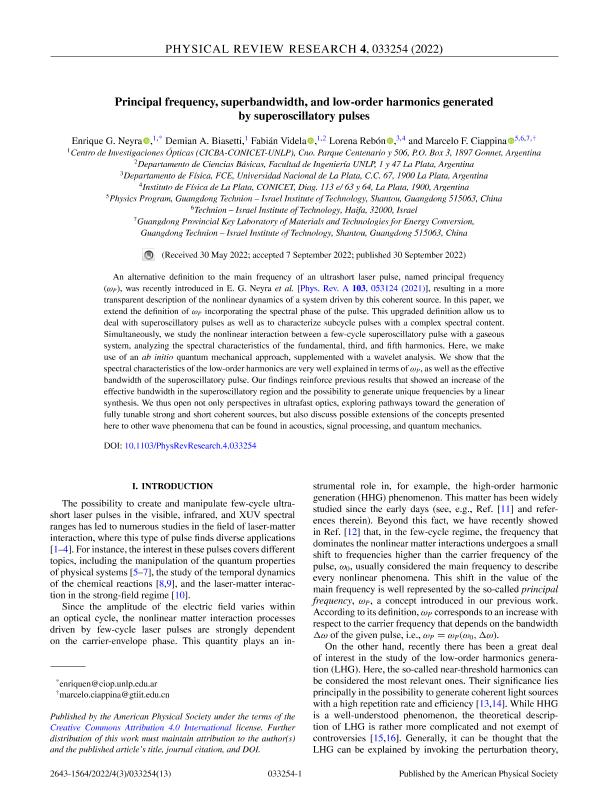Artículo
Principal frequency, superbandwidth, and low-order harmonics generated by superoscillatory pulses
Neyra, Enrique Gustavo ; Biasetti, Demian Arístide
; Biasetti, Demian Arístide ; Videla, Fabian Alfredo; Rebón, Lorena
; Videla, Fabian Alfredo; Rebón, Lorena ; Ciappina, Marcelo F.
; Ciappina, Marcelo F.
 ; Biasetti, Demian Arístide
; Biasetti, Demian Arístide ; Videla, Fabian Alfredo; Rebón, Lorena
; Videla, Fabian Alfredo; Rebón, Lorena ; Ciappina, Marcelo F.
; Ciappina, Marcelo F.
Fecha de publicación:
09/2022
Editorial:
American Physical Society
Revista:
Physical Review Research
ISSN:
2643-1564
Idioma:
Inglés
Tipo de recurso:
Artículo publicado
Clasificación temática:
Resumen
An alternative definition to the main frequency of an ultrashort laser pulse, named principal frequency (ωP), was recently introduced in E. G. Neyra et al. [Phys. Rev. A 103, 053124 (2021)2469-992610.1103/PhysRevA.103.053124], resulting in a more transparent description of the nonlinear dynamics of a system driven by this coherent source. In this paper, we extend the definition of ωP incorporating the spectral phase of the pulse. This upgraded definition allow us to deal with superoscillatory pulses as well as to characterize subcycle pulses with a complex spectral content. Simultaneously, we study the nonlinear interaction between a few-cycle superoscillatory pulse with a gaseous system, analyzing the spectral characteristics of the fundamental, third, and fifth harmonics. Here, we make use of an ab initio quantum mechanical approach, supplemented with a wavelet analysis. We show that the spectral characteristics of the low-order harmonics are very well explained in terms of ωP, as well as the effective bandwidth of the superoscillatory pulse. Our findings reinforce previous results that showed an increase of the effective bandwidth in the superoscillatory region and the possibility to generate unique frequencies by a linear synthesis. We thus open not only perspectives in ultrafast optics, exploring pathways toward the generation of fully tunable strong and short coherent sources, but also discuss possible extensions of the concepts presented here to other wave phenomena that can be found in acoustics, signal processing, and quantum mechanics.
Archivos asociados
Licencia
Identificadores
Colecciones
Articulos(CIOP)
Articulos de CENTRO DE INVEST.OPTICAS (I)
Articulos de CENTRO DE INVEST.OPTICAS (I)
Articulos(IFLP)
Articulos de INST.DE FISICA LA PLATA
Articulos de INST.DE FISICA LA PLATA
Citación
Neyra, Enrique Gustavo; Biasetti, Demian Arístide; Videla, Fabian Alfredo; Rebón, Lorena; Ciappina, Marcelo F.; Principal frequency, superbandwidth, and low-order harmonics generated by superoscillatory pulses; American Physical Society; Physical Review Research; 4; 3; 9-2022; 1-13
Compartir
Altmétricas



